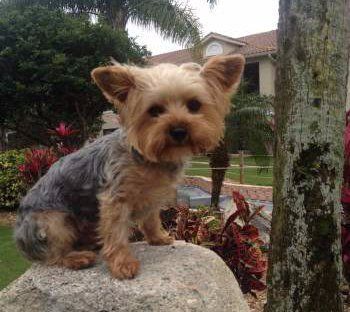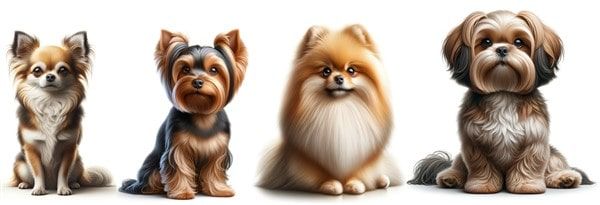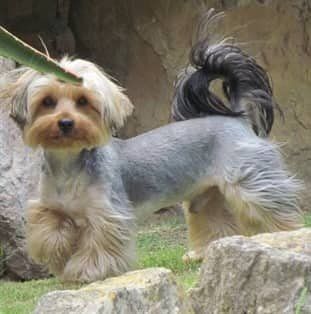Yorkshire Terrier Size
Overview
Please note:
YorkieInfoCenter
is reader-supported, and some of the product suggestions on this page are affiliate links. As an Amazon Associate we earn from qualifying purchases. This is at no extra cost to you and helps us continue providing free, high-quality information.
Expected Size of Yorkshire Terriers
How the Yorkshire Terrier Compares in Size to Other Toy Breeds
Let’s take a look at how the Yorkie compares to other dogs in the toy breed class.
Below is a list of the AKC breed standard sizes of the Yorkshire Terrier and other popular toy breeds. Note that height is measured from the floor to the top of the shoulders.
- Chihuahua: Weight: No more than 6 lbs. Height: 6 - 9 inches
- Yorkshire Terrier: Weight: No more than 7 lbs. Height: 6 - 9 inches
- Pomeranian: Weight: 3 - 7 lbs. Height: 7 - 12 inches
- Shih Tzu: Weight: 9 - 16 lbs. Height: 9 - 11 inches
- Pug: Weight: 14 - 18 lbs. Height: 12 - 14 inches
- Papillon: Weight: 5 - 10 lbs. Height 8 - 11 inches
- Havanese: Weight: 7 - 13 lbs. Height: 8.5 - 11.5 inches
- Brussels Griffon: Weight 8 - 10 lbs. Height: 7 - 10 inches
- Pekingese: Weight Up to 14 lbs. Height: 7 - 10 inches
- Japanese Chin: Weight 7 -11 lbs. Height: 8 - 11 inches
- Silky Terrier: No official weight, but normally 10 -11 lbs. Height 9 - 10 inches
- Bichon Frise: Weight 12 - 18 lbs. Height: 9.1 - 12 inches
A Note on Smaller than Average Yorkshire Terriers
Smaller-than-average Yorkshire Terriers, also known as teacup Yorkies, while adorable, are predisposed to a unique set of health challenges that potential owners should consider. Among these, hypoglycemia is notably prevalent due to their limited muscle mass for glucose storage and smaller liver size, which can lead to dangerous drops in blood sugar levels.
Dental issues also arise from overcrowded teeth in their tiny jaws, increasing the risk of periodontal disease and tooth decay. Additionally, their delicate bone structure makes them more susceptible to fractures, requiring careful handling to prevent injuries.
Respiratory problems, such as a collapsed trachea, are common health concerns for these small Yorkies, attributed to their diminutive size rather than the brachycephalic issues seen in other breeds. Furthermore, conditions like Portosystemic shunts (PSS) are observed with a higher frequency, where abnormal blood flow bypasses the liver, leading to a buildup of toxins. These health issues underscore the importance of regular veterinary care, a balanced diet, and gentle, protective handling to ensure the well-being of smaller-than-average Yorkshire Terriers.
A Note on Larger than Normal Yorkshire Terriers
Slightly Larger:
As touched on earlier, despite the breed standard stipulating that Yorkshire Terriers should not exceed 7 lbs. (3.18 kg), a significant number of adult Yorkies actually weigh more, with our poll indicating that about 21% fall into this category. This highlights a considerable diversity in size within the breed.
Why do we see Yorkies larger than the average? In some instances, a Yorkshire Terrier might reach or even surpass 7 pounds, contrary to an owner's initial expectation of a smaller, 4-pound dog. Often, this discrepancy is merely a matter of perception versus reality. However, it's crucial to note that the 7-pound maximum is primarily a guideline for AKC show conformation. Consequently, Yorkshire Terriers weighing 8 or 9 pounds can still be perfectly healthy, purebred specimens.
Genetics play a significant role in this size variation, with traits potentially influenced by ancestors up to five generations back or more. As such, while the sizes of the dam and sire can offer some prediction of a litter's characteristics, there's always a natural variability in the offspring's eventual size and body structure.
That being said, Yorkies weighing over 10 pounds should be assessed for potential excess weight (see below: If a Yorkie is Large Due to Excess Weight), which, although uncommon in this breed, is possible. It's also important to consider that an appropriate weight can vary with a dog's height; for instance, a 10-pound Yorkie might not be overweight if they are taller, measuring in the 10 to 11-inch range.
Considerably Larger:
When it comes to Yorkshire Terriers exceeding 10 pounds, there might be more factors at play than initially meets the eye. In several instances, the lineage might include genes from another breed, which could raise questions about the dog's purebred status. It's a common misconception that a registered purebred cannot have mixed lineage. The American Kennel Club (AKC), for instance, requires a three-generation pedigree for a dog to be classified as purebred (though four and five generation research pedigrees are an option). This leaves room for genetic contributions from other breeds in earlier generations.
Another scenario involves accidental mix-breeding. While the AKC has made strides in preventing this through DNA testing, the system largely relies on breeder honesty, opening the door to both intentional and unintentional misinformation.
A particularly interesting aspect of canine reproduction is the possibility of double-sired litters, where offspring in the same litter have different fathers. This can occur if a female mates with a Yorkshire Terrier and another dog of a different breed, yet only the Yorkie is registered as the sire. This could result in unexpectedly large puppies, some of which may be mixed breed.
Observers might question how a Yorkie could appear purely bred while harboring genes from a larger breed. One explanation is the resemblance between Yorkies and other larger terrier breeds, such as the Australian Terrier, which weighs on average between 12 to 14 pounds and shares physical traits with Yorkies. A significant indicator of mixed heritage can be ear shape; while some Yorkies may have naturally floppy ears, predominant drop ears in a larger-than-average Yorkie could suggest the presence of another breed in its lineage.
Photos of Larger than Average Yorkies
Every now and then there will be a purebred Yorkshire Terrier that is much bigger than expected.
Above is Womble at 1.5 years old and 11 lbs. (5 kg); photo courtesy of Tony T.
And above is Osso, at 4 years old and 17 lbs. (7.7 kg).
Both the parents and grandparents are personally known to this family and are purebreds.
Photo courtesy of Karina H.

Above is Jack, 4 months old and already 6 lbs.
Photo courtesy of Laurie H. (Grandma of Jack)
If a Yorkie is Large Due to Excess Weight:
A note about puppies: Puppies grow a lot during the first year. With some, growth will be spread out over the course of the first year. With others, there will be growth spurt, with slower changes some months and incredibly noticeable growth in others.
Puppies should neither be put on a restrictive diet nor over-exercised. It's entirely normal for them to carry "puppy fat," giving them a somewhat round appearance, which is to be expected during their growth phase. Around the 9-month mark, weight gain typically slows down, though a Yorkie may continue to grow slightly in height and length, leading to a leaner appearance. By this stage, their muscles are nearly fully developed, contributing to a more streamlined and sleek form.






